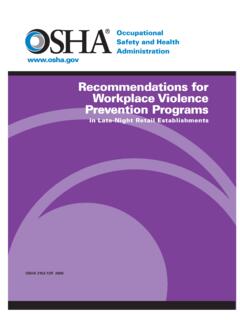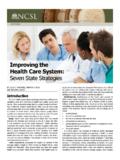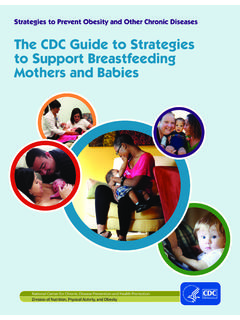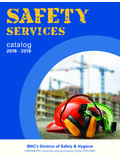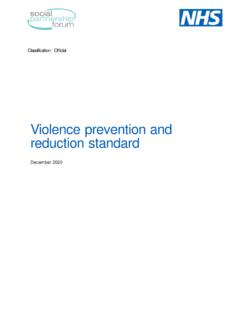Transcription of Guidance for the Selection and Use of Personal Protective ...
1 1 Guidance for the Selection and Use of Personal Protective Equipment (PPE) in Healthcare Settings2 PPE Use in Healthcare Settings:Program GoalImprove personnel safety in the healthcare environment through appropriate use of PPE. PPE Use in Healthcare SettingsThe goal of this program is to improve personnel safety in the healthcare environment through appropriate use of Use in Healthcare Settings: Program Objectives Provide information on the Selection and use of PPE in healthcare settings Practice how to safely don and remove PPEPPE Use in Healthcare SettingsThe objectives of this program are to provide information on the Selection and use of PPE in healthcare settings and to allow time for participants to practice the correct way to don and remove Protective Equipment Definition specialized clothing or equipment worn by an employee for protection against infectious materials (OSHA)PPE Use in Healthcare SettingsPersonal Protective equipment, or PPE, as defined by the Occupational Safety and Health Administration, or OSHA, is specialized clothing or equipment, worn by an employee for protection against infectious materials.
2 5 Regulations and Recommendations for PPE OSHA issues workplace health and safety regulations. Regarding PPE, employers must: Provide appropriate PPE for employees Ensure that PPE is disposed or reusable PPE is cleaned, laundered, repaired and stored after use OSHA also specifies circumstances for which PPE is indicated CDC recommends when, what and how to use PPEPPE Use in Healthcare SettingsOSHA issues regulations for workplace health and safety. These regulations require use of PPE in healthcare settings to protect healthcare personnel from exposure to bloodborne pathogens and Mycobacterium tuberculosis. However, under OSHA sGeneral Duty Clause PPE is required for any potential infectious disease exposure. Employers must provide their employees with appropriate PPE and ensure that PPE is disposed or, if reusable, that it is properly cleaned or laundered, repaired and stored after use.
3 The Centers for Disease Control and prevention (CDC) issues recommendations for when and what PPE should be used to prevent exposure to infectious diseases. This presentation will cover those recommendations, beginning with the hierarchy of safety and health of Safety and Health Controls Training and administrative controls Engineering controls Work practice controls Personal Protective equipmentPPE Use in Healthcare SettingsThe protection of healthcare personnel from infectious disease exposures in the workplace requires a combination of controls, one of which is the use of PPE. It is important to recognize that your protection as a healthcare worker also involves other prevention strategies . There are four major components to healthcare worker safety programs.
4 First are training, such as you re receiving today, and administrative controls, like isolation policies and procedures, and procedures for recognizing patients with a communicable disease before they expose workers. Second are engineering controls like negative pressure rooms for patients with airborne diseases such as TB; third are work practice controls such as not recapping needles, and finally Personal Protective equipment . While PPE is last in the hierarchy of prevention , it is very important for protecting healthcare workers from disease of PPE Used in Healthcare Settings Gloves protect hands Gowns/aprons protect skin and/or clothing Masks and respirators protect mouth/nose Respirators protect respiratory tract from airborne infectious agents Goggles protect eyes Face shields protect face, mouth, nose, and eyesPPE Use in Healthcare SettingsAll of the PPE listed here prevent contact with the infectious agent, or body fluid that may contain the infectious agent, by creating a barrier between the worker and the infectious material.
5 Gloves, protect the hands, gowns or aprons protect the skin and/or clothing, masks and respirators protect the mouth and nose, goggles protect the eyes, and face shields protect the entire respirator, has been designed to also protect the respiratory tract from airborne transmission of infectious agents. We ll discuss this in more detail Influencing PPE Selection Type of exposure anticipated Splash/spray versus touch Category of isolation precautions Durability and appropriateness for the task FitPPE Use in Healthcare SettingsWhen you are selecting PPE, consider three key things. First is the type of anticipated exposure. This is determined by the type of anticipated exposure, such as touch, splashes or sprays, or large volumes of blood or body fluids that might penetrate the clothing.
6 PPE Selection , in particular the combination of PPE, also is determined by the category of isolation precautions a patient is on. Second, and very much linked to the first, is the durability and appropriateness of the PPE for the task. This will affect, for example, whether a gown or apron is selected for PPE, or, if a gown is selected, whether it needs to be fluid resistant, fluid proof, or is fit. (optional question) How many of you have seen someone trying towork in PPE that is too small or large? PPE must fit the individual user, and it is up to the employer to ensure that all PPE are available in sizes appropriate for the workforce that must be protected.(Segue to next slide) With this as background, let s now discuss how to select and use specific PPE.
7 After that we ll talk about which PPE is recommended for Standard Precautions and the various Isolation Precaution Purpose patient care, environmental services, other Glove material vinyl, latex, nitrile, other Sterile or nonsterile One or two pair Single use or reusablePPE Use in Healthcare SettingsGloves are the most common type of PPE used in healthcare settings. As you can see here, there are several things to consider when selecting the right glove for a specified Purpose patient care, environmental services, other Glove material vinyl, latex, nitrile, other Sterile or non-sterile Oneor two pair Single useor reusablePPE Use in Healthcare SettingsMost patient care activities require the use of a single pair of nonsterile gloves made of either latex, nitrile, or vinyl.
8 However, because of allergy concerns, some facilities have eliminated or limited latex products, including gloves, and now use gloves made of nitrile or other material. Vinyl gloves are also frequently available and work well if there is limited patient contact. However, some gloves do not provide a snug fit on the hand, especially around the wrist, and therefore should not be used if extensive contact is should fit the user s hands comfortably they should not be too loose or too tight. They also should not tear or damage easily. Gloves are sometimes worn for several hours and need to stand up to the uses the other glove options? Sterile surgical gloves are worn by surgeons and other healthcare personnel who perform invasive patient procedures.
9 During some surgical procedures, two pair of gloves may be worn. Environmental services personnel often wear reusable heavy duty gloves made of latex or nitrile to work with caustic disinfectants when cleaning environmental surfaces. However, they sometimes use patient care gloves s and Don ts of Glove Use Work from clean to dirty Limit opportunities for touch contamination -protect yourself, others, and the environment Don t touch your face or adjust PPE with contaminated gloves Don t touch environmental surfaces except as necessary during patient carePPE Use in Healthcare SettingsGloves protect you against contact with infectious materials. However, once contaminated, gloves can become a means for spreading infectious materials to yourself, other patients or environmental surfaces.
10 Therefore, the way YOU use gloves can influence the risk of disease transmission in your healthcare setting. These are the most important do s and don'ts of glove from clean to is a basic principle of infection control. In this instance it refers to touching clean body sites or surfaces before you touch dirty or heavily contaminated areas. Limit opportunities for touch contamination - protect yourself, others and environmental surfaces. How many times have you seen someone adjust their glasses, rub their nose or touch their face with gloves that have been in contact with a patient? This is one example of touch contamination that can potentially expose oneself to infectious agents. Think about environmental surfaces too and avoid unnecessarily touching them with contaminated gloves.











